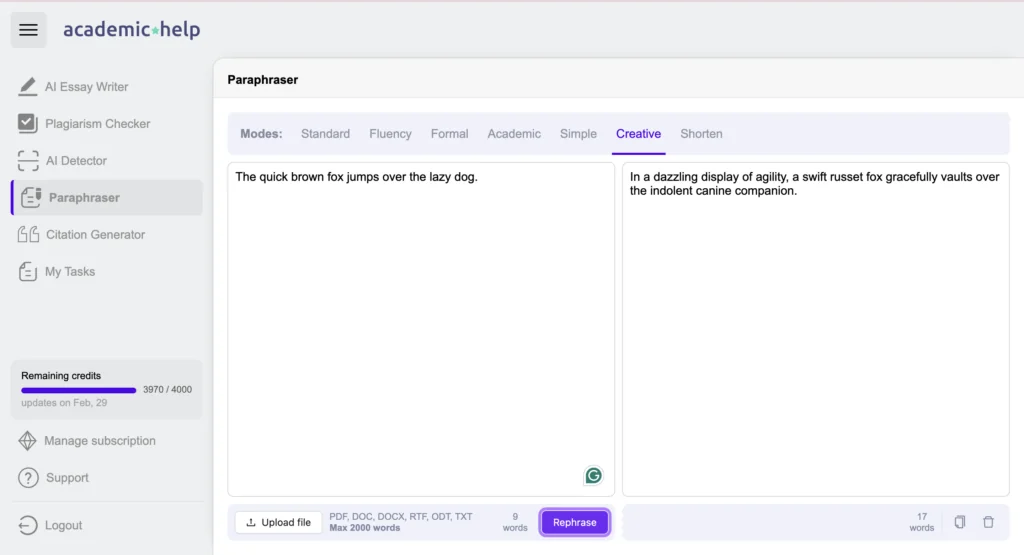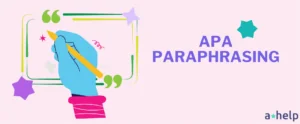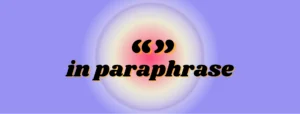In the bustling world of academia, where the pen is mightier than the sword, students often find themselves in the throes of crafting papers that are both insightful and original. Yet, one of the most nuanced skills that remains a thorn in the side for many is the art of paraphrasing. How does one take the essence of an idea, cloaked in another’s words, and reweave it into something fresh and new, yet equally potent?

✅ AI Essay Writer ✅ AI Detector ✅ Plagchecker ✅ Paraphraser
✅ Summarizer ✅ Citation Generator
Paraphrasing vs Quoting
While both quoting and paraphrasing serve to incorporate external sources into your work, they differ significantly in application. Quoting involves directly copying an excerpt from a source, maintaining its exact wording, and using quotation marks to denote the original author’s work.
Quoting: “To be, or not to be, that is the question.” (Gamlet, Shakespeare)
Paraphrasing, on the other hand, entails rewording and rephrasing the essence of the source’s content in your own words.
Paraphrasing: “The dilemma lies in choosing between existence and oblivion”.
Examples
Good paraphrasing involves more than just changing a few words here and there; it requires a deep understanding and an almost complete reimagining of the original text. For example:
Original: “All the world’s a stage, and all the men and women merely players.”
Paraphrased: The entire planet is likened to a theatrical platform where every individual plays a specific role.
This paraphrase is effective because it captures Shakespeare’s metaphorical concept using entirely different language and structure, demonstrating comprehension and creativity. Thus, it can’t be seen as mere copying of content, but rather as its unique interpretation (which is what paraphrasing initially is).
Paraphrasing in 5 Easy Steps
Quality paraphrasing is not just swapping words with synonyms. Oh no, in reality, it’s more about understanding and then reinterpreting the text. Here’s how to achieve this in five simple steps:
- Read and Comprehend: Begin by reading the original text thoroughly until you grasp its full meaning. Without understanding, effective paraphrasing is impossible.
- Note Key Points: Identify and note down the key points or concepts presented in the text. This helps in focusing on the essence rather than the exact wording.
- Write Without Looking: Set the original text aside and write down your understanding of the information, relying solely on memory. This encourages originality in expression.
- Compare with the Original: Once you have your version, compare it with the original text. Ensure that you’ve accurately captured the core ideas while using different phrasing.
- Revise and Edit: Make any necessary adjustments to refine the paraphrase, ensuring clarity and a smooth flow of ideas.
You may use the advanced rewording generator to grasp the idea. For example, consider paraphrasing the following text:
Original: “The quick brown fox jumps over the lazy dog.”
Paraphrased: A swift, brown fox leaps across a sluggish canine.
Below you can also see another variant (a more creative one) of an effective paraphrasing.

How to Avoid Plagiarism When Paraphrasing
The line between paraphrasing and plagiarism can be thin if not navigated with care. The act of paraphrasing, when done correctly, is not just a cosmetic alteration of the source material but a comprehensive re-articulation of its core ideas in your unique voice and style. Simply put, you won’t reach the needed level of originality by substituting words with synonyms. You need to interpret what’s been said in your own words and style. To ensure that your paraphrasing efforts steer clear of plagiarism, here are expanded guidelines to keep in mind.
Always Provide a Citation to the Original Source
Citing the original source is important, irrespective of how extensively you have paraphrased the content. This practice not only honors the intellectual property rights of the original author but also lends credibility to your work by referencing authoritative sources. A citation should include all necessary details such as the author’s name, publication date, and if possible, the page number or paragraph from where the idea is derived. This transparency allows readers to trace the evolution of ideas and recognize the foundational work behind your narrative.
Ensure that the Paraphrased Content Is Significantly Different in Wording and Structure from the Original
Effective paraphrasing involves more than just a superficial exchange of words with synonyms. It requires a thorough reevaluation and reconstruction of the original text. This means not only changing the words but also altering the sentence structure, employing different grammatical constructions, and possibly reorganizing the presentation of ideas to reflect your understanding and perspective. The goal is to use your voice to convey the same message, which demonstrates your grasp of the subject matter and contributes to the originality of your work.
Use Plagiarism Checkers to Verify the Uniqueness of Your Paraphrase Against the Original Text
In today’s digital age, numerous tools and software are available to help identify similarities between your text and existing materials. Plagiarism checkers can be invaluable in ensuring that your paraphrased content is sufficiently distinct from the source material. By submitting your work to a plagiarism scanner, you can detect any unintentional overlap and make necessary adjustments. Remember, a successful paraphrase will not trigger plagiarism detection software, affirming the originality of your rendition.
Avoid Over-Reliance on the Source’s Vocabulary or Sentence Structure
One common pitfall in paraphrasing is the tendency to stick too closely to the source’s vocabulary and sentence patterns. To avoid this, focus on fully digesting the meaning of the text before attempting to paraphrase it. Once you understand the content thoroughly, express the ideas using your knowledge base, experiences, and linguistic style. This approach not only ensures a genuine paraphrase but also enriches your writing with a diversity of expression and depth.
The Testament to the Writer’s Understanding and Interpretation
Ultimately, the quality of your paraphrased content is a reflection of your comprehension and analytical skills. A well-paraphrased passage not only passes plagiarism checks but also showcases your ability to assimilate complex information and reframe it in a context that is both accessible and engaging to your audience. It is your interpretation, after all, that breathes new life into the ideas borrowed from the source material, making them resonate within your unique scholarly or creative discourse.
*Side Note: If you can’t in any way rephrase a quote that you want to include in you work DO NOT torture yourself. Insert is as a “direct quote” specifying who said it. Include a relevant in-text citation as well as a reference entry in your bibliography.
Conclusion
Effective paraphrasing is an art that marries comprehension with creativity, allowing writers to weave the thoughts of others into their narrative tapestry, enriched and transformed. It is a skill that, when honed, not only enhances the quality of academic writing but also safeguards the integrity of the scholarly work. By understanding the essence of the original text and re-presenting it in a new light, one does not merely avoid the pitfalls of plagiarism but also pays homage to the original idea, giving it new life and perspective. Thus, effective paraphrasing is not just about altering words but about re-envisioning ideas, a critical skill in the arsenal of any successful academic writer. To further explore the power of paraphrasing consider testing a rewording tool by A-Help.
FAQ
Follow us on Reddit for more insights and updates.





Comments (0)
Welcome to A*Help comments!
We’re all about debate and discussion at A*Help.
We value the diverse opinions of users, so you may find points of view that you don’t agree with. And that’s cool. However, there are certain things we’re not OK with: attempts to manipulate our data in any way, for example, or the posting of discriminative, offensive, hateful, or disparaging material.